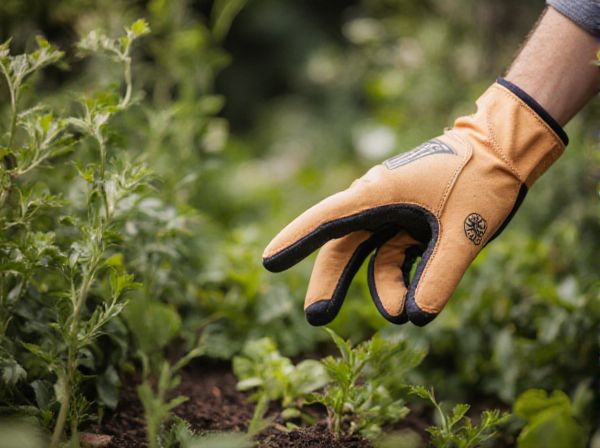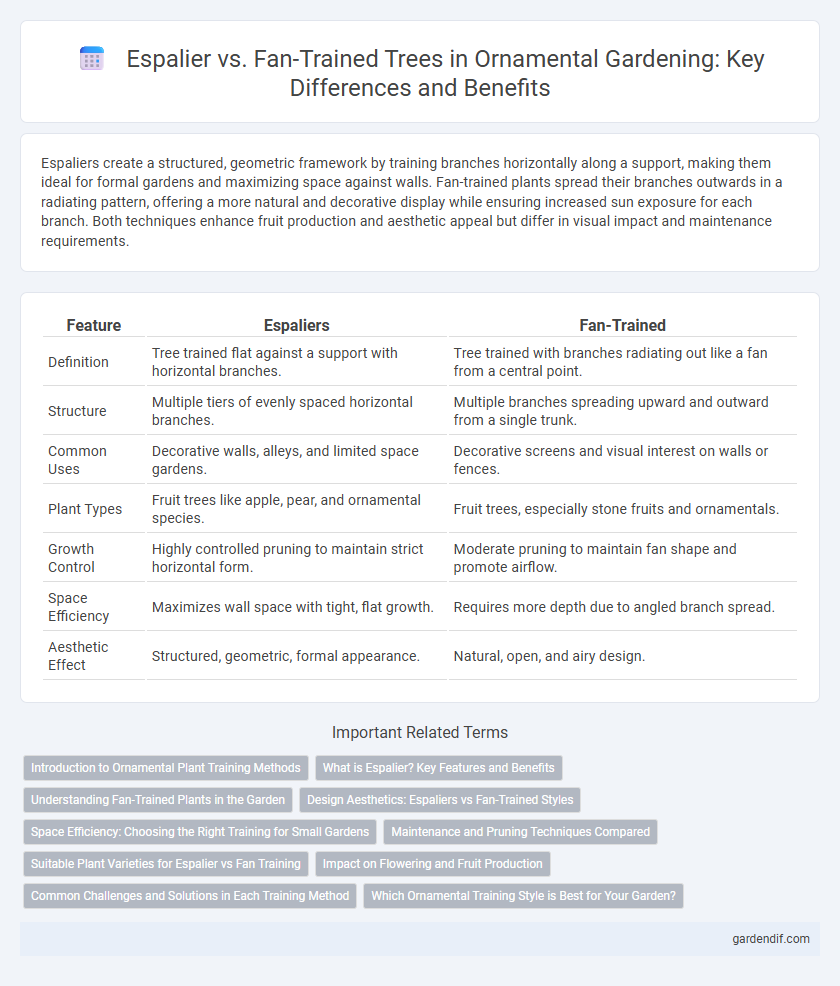
Espaliers vs Fan-Trained Illustration
Espaliers create a structured, geometric framework by training branches horizontally along a support, making them ideal for formal gardens and maximizing space against walls. Fan-trained plants spread their branches outwards in a radiating pattern, offering a more natural and decorative display while ensuring increased sun exposure for each branch. Both techniques enhance fruit production and aesthetic appeal but differ in visual impact and maintenance requirements.
Table of Comparison
| Feature | Espaliers | Fan-Trained |
|---|---|---|
| Definition | Tree trained flat against a support with horizontal branches. | Tree trained with branches radiating out like a fan from a central point. |
| Structure | Multiple tiers of evenly spaced horizontal branches. | Multiple branches spreading upward and outward from a single trunk. |
| Common Uses | Decorative walls, alleys, and limited space gardens. | Decorative screens and visual interest on walls or fences. |
| Plant Types | Fruit trees like apple, pear, and ornamental species. | Fruit trees, especially stone fruits and ornamentals. |
| Growth Control | Highly controlled pruning to maintain strict horizontal form. | Moderate pruning to maintain fan shape and promote airflow. |
| Space Efficiency | Maximizes wall space with tight, flat growth. | Requires more depth due to angled branch spread. |
| Aesthetic Effect | Structured, geometric, formal appearance. | Natural, open, and airy design. |
Introduction to Ornamental Plant Training Methods
Espaliers and fan-trained plants represent two distinctive ornamental training methods that enhance aesthetic appeal while maximizing space efficiency. Espalier involves training plants, typically fruit trees, into flat, two-dimensional forms along a support structure, emphasizing symmetry and controlled growth. Fan-trained plants, often used for climbers and vines, are pruned and tied to spread out in a fanned pattern, creating an elegant display of branches and foliage.
What is Espalier? Key Features and Benefits
Espalier is a horticultural technique that trains trees or shrubs to grow flat against a support, creating a decorative, space-saving vertical garden feature. Key features include precise pruning, structured branches, and enhanced sunlight exposure, which improve air circulation and fruit production. Benefits of espalier include increased aesthetic appeal, efficient use of limited space, and easier maintenance and harvesting compared to freely grown plants.
Understanding Fan-Trained Plants in the Garden
Fan-trained plants create an elegant, open structure by guiding branches outward in a semicircular pattern against a support, maximizing sunlight exposure and air circulation. This technique differs from espaliers, which form a flat, two-dimensional outline against a wall. Gardeners often choose fan training for species like fruit trees and climbing roses to enhance decorative appeal while optimizing plant health and fruit production.
Design Aesthetics: Espaliers vs Fan-Trained Styles
Espaliers feature a structured, linear design with branches trained to grow flat against a support, creating a formal and geometric appearance ideal for minimalist gardens. Fan-trained styles spread branches radially from a single point, producing a more natural and decorative fan-like shape that enhances visual interest in ornamental spaces. Both techniques offer unique aesthetic value, with espaliers emphasizing symmetry and repetition, while fan-trained designs provide dynamic texture and organic flow.
Space Efficiency: Choosing the Right Training for Small Gardens
Espaliers and fan-trained designs both maximize space efficiency, but espaliers are ideal for narrow walls or fences as they grow flat against a surface, saving horizontal space. Fan-trained plants spread outward, offering greater airflow and sunlight exposure, making them suitable for slightly wider areas without compromising garden width. Selecting the right training method depends on available wall length and desired airflow, optimizing small garden fruit production and ornamental appeal.
Maintenance and Pruning Techniques Compared
Espaliers require precise, structured pruning to maintain their flat, two-dimensional growth against a support, emphasizing regular removal of lateral shoots and training along horizontal wires. Fan-trained plants demand more flexible pruning to encourage multiple stems radiating from a single point, focusing on thinning and shaping each branch evenly for balanced airflow and light penetration. Both techniques benefit from seasonal pruning in late winter or early spring to promote healthy growth and fruit production, but espaliers often demand more frequent, meticulous attention to preserve their strict form.
Suitable Plant Varieties for Espalier vs Fan Training
Espaliers are best suited for fruit trees like apples, pears, and stone fruits due to their strong central leader and horizontal branching structure, which supports efficient fruit production and easy maintenance. Fan training works well with woody climbers such as vines, roses, and jasmine, allowing the branches to spread out in a radial pattern against a flat surface, enhancing air circulation and flowering. Both techniques optimize space usage but require plant varieties that naturally adapt to their respective training styles for optimal growth and ornamental appeal.
Impact on Flowering and Fruit Production
Espaliers create a structured framework that maximizes sunlight exposure and air circulation, promoting robust flowering and more uniform fruit production. Fan-trained plants spread their branches outward, enhancing light penetration and facilitating better pollination, which can lead to increased fruit yield and size. Both techniques improve fruit quality, but espaliers often result in more evenly distributed flowers and easier harvest compared to fan-trained forms.
Common Challenges and Solutions in Each Training Method
Espaliers often face challenges such as limited space for lateral branch growth and the risk of weak framework if not pruned correctly, which can be mitigated by consistent training and timely removal of competing shoots. Fan-trained plants commonly struggle with uneven branch distribution and overcrowding, leading to poor air circulation and disease susceptibility; regular thinning and careful spacing improve airflow and overall plant health. Both methods require vigilant monitoring for pests and diseases, with tailored pruning strategies enhancing structural strength and ornamental appeal.
Which Ornamental Training Style is Best for Your Garden?
Espaliers create a formal, structured aesthetic by training trees flat against a wall or trellis, maximizing space and enhancing fruit production, ideal for small gardens with limited room. Fan-trained plants spread branches in a wide, open pattern, offering a more natural, decorative look that complements ornamental gardens with ample space for air circulation. Choosing between espaliers and fan-trained styles depends on your garden's design goals, spatial constraints, and whether you prioritize fruit yield or ornamental appeal.
Espaliers vs Fan-Trained Infographic

 gardendif.com
gardendif.com